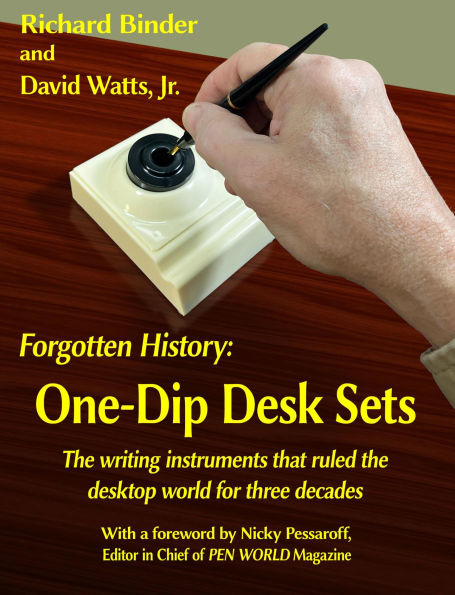From the 1930s into the 1960s, if you used a desk pen in the workplace, at a bank, or in your attorney's office, you most likely wrote with a "one-dip" pen. Less expensive to buy than fountain-pen desk sets and more economical to use, one-dip sets were produced by important ink and pen makers such as Esterbrook, Carter's, Sanford's, Fount-O-Ink, Sengbusch, and even Sheaffer's.
When they think of desk pens, most pen collectors think of dip pens—which tend to be messy and scratchy, with no tipping material on their nibs—or fountain pen desk sets. But the one-dip desk sets, unheralded and now largely forgotten, were just as prominent in their day.
These pens ofter are mistakenly called "dipless," a misappropriation of Esterbrook's Dip-Less brand, which connoted less dipping than their dip-pen predecessors. They are not in fact dipless; they just require much less frequent dipping because the pens have the ability to hold enough ink to write 200–300 words or more.
This book, the world's first devoted to this fascinating genre of pens with iconically designed bases that evoke the Art Deco, Moderne, and Streamline periods and come in many beautiful colors, will take you through the decades of the rise and golden years of these remarkable writing instruments.
1146332555
When they think of desk pens, most pen collectors think of dip pens—which tend to be messy and scratchy, with no tipping material on their nibs—or fountain pen desk sets. But the one-dip desk sets, unheralded and now largely forgotten, were just as prominent in their day.
These pens ofter are mistakenly called "dipless," a misappropriation of Esterbrook's Dip-Less brand, which connoted less dipping than their dip-pen predecessors. They are not in fact dipless; they just require much less frequent dipping because the pens have the ability to hold enough ink to write 200–300 words or more.
This book, the world's first devoted to this fascinating genre of pens with iconically designed bases that evoke the Art Deco, Moderne, and Streamline periods and come in many beautiful colors, will take you through the decades of the rise and golden years of these remarkable writing instruments.
Forgotten History: One-Dip Desk Sets: The writing instruments that ruled the desktop world for three decades
From the 1930s into the 1960s, if you used a desk pen in the workplace, at a bank, or in your attorney's office, you most likely wrote with a "one-dip" pen. Less expensive to buy than fountain-pen desk sets and more economical to use, one-dip sets were produced by important ink and pen makers such as Esterbrook, Carter's, Sanford's, Fount-O-Ink, Sengbusch, and even Sheaffer's.
When they think of desk pens, most pen collectors think of dip pens—which tend to be messy and scratchy, with no tipping material on their nibs—or fountain pen desk sets. But the one-dip desk sets, unheralded and now largely forgotten, were just as prominent in their day.
These pens ofter are mistakenly called "dipless," a misappropriation of Esterbrook's Dip-Less brand, which connoted less dipping than their dip-pen predecessors. They are not in fact dipless; they just require much less frequent dipping because the pens have the ability to hold enough ink to write 200–300 words or more.
This book, the world's first devoted to this fascinating genre of pens with iconically designed bases that evoke the Art Deco, Moderne, and Streamline periods and come in many beautiful colors, will take you through the decades of the rise and golden years of these remarkable writing instruments.
When they think of desk pens, most pen collectors think of dip pens—which tend to be messy and scratchy, with no tipping material on their nibs—or fountain pen desk sets. But the one-dip desk sets, unheralded and now largely forgotten, were just as prominent in their day.
These pens ofter are mistakenly called "dipless," a misappropriation of Esterbrook's Dip-Less brand, which connoted less dipping than their dip-pen predecessors. They are not in fact dipless; they just require much less frequent dipping because the pens have the ability to hold enough ink to write 200–300 words or more.
This book, the world's first devoted to this fascinating genre of pens with iconically designed bases that evoke the Art Deco, Moderne, and Streamline periods and come in many beautiful colors, will take you through the decades of the rise and golden years of these remarkable writing instruments.
5.99
In Stock
5
1

Forgotten History: One-Dip Desk Sets: The writing instruments that ruled the desktop world for three decades

Forgotten History: One-Dip Desk Sets: The writing instruments that ruled the desktop world for three decades
Related collections and offers
5.99
In Stock

Product Details
| BN ID: | 2940186118589 |
|---|---|
| Publisher: | Richard Binder |
| Publication date: | 09/24/2024 |
| Sold by: | Barnes & Noble |
| Format: | eBook |
| File size: | 13 MB |
| Note: | This product may take a few minutes to download. |
About the Author
From the B&N Reads Blog
